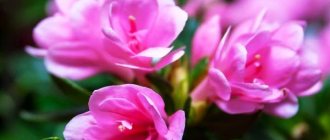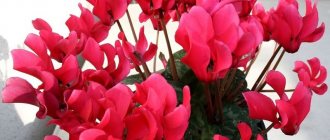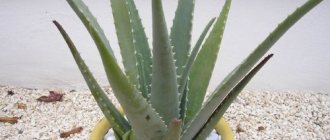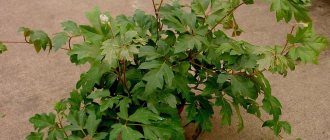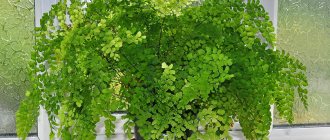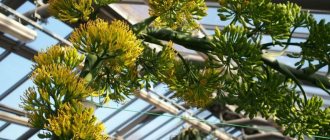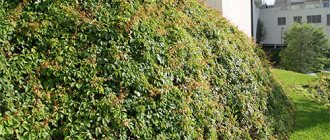A houseplant in the form of an evergreen vine with luxurious decorative leaves is called birch or cissus. Growing such a green decoration, which belongs to the Grape family, is not particularly difficult. The leaves of this hanging plant are diamond-shaped, the flowers are small and inconspicuous. At home, the home birch flower rarely blooms.
Cissus - home care for indoor birch
Cissus - kissos (Greek), means "ivy" , another name for "indoor grape" , is a vine of tropical origin.
In nature, it is found in many tropical and subtropical jungles of both hemispheres. its popular nickname “birch” because of its leaves, which are very similar to birch leaves. With proper care, it produces small flowers, which then turn into small berries . It clings to supports using antennae.
At home, indoor birch trees are grown in hanging pots, and then the birch shoots fall in the form of a green cascade, or are directed upward with the help of supports. You can make a wonderful combined composition when one part of the branches hangs freely downwards, and the other is directed upwards.
There is a long-standing belief that indoor birch gives a person strength, improves health, and prevents infections from colds. Absolutely unpretentious, quite simple in appearance, this plant can provide a huge amount of green mass, turning a room into a real greenhouse.
Popular birch varieties for growing at home
Antarctic cissus is a species with entire, serrated, ovate leaves. It tolerates shaded corners of the room well and clings to the support with the help of antennae. The reverse side of the foliage has red pubescence. This species does not tolerate dryness in winter and too high temperatures, as well as shading.
Cissus rhombifolia is a species with beautiful carved foliage, the leaf blade is tripartite. Often grown in pots without direct sunlight. The length of the lashes increases to 2 m over the season.
"Ellen Danica" is a flower with beautiful dissected leaves.
Cissus multicolored is a species that does not like temperature changes and direct sunlight. The front part of the leaf plate has beautiful white stripes, the back side is purple. The plant needs support. This species tolerates shade well.
Cissus cactus is a rare indoor species with thickened shoots that clings to support with tendrils.
Cissus rotundifolia - leaf plates are ovoid in shape with a serrated edge.
Types of indoor cissus
There are more than 300 species in nature, but much fewer are domesticated. This:
- quadrangular (cactus-shaped) - the shoots are thick, about 1 cm in diameter, tetrahedral (hence the name). The leaves consist of three parts, are small, and fall quickly. The species is photophilous and grows quite slowly.
- bicolor (multi-colored) - a climbing shrub with ellipsoid leaf blades covered with silver spots with a purple tint. The flowers are yellow, collected in umbrellas.
- Antarctic - the leaves have the shape of an elongated heart, herbaceous - green. The flowers look like little green umbrellas.
- rhombifolia - a fast-growing vine that requires support, the shoots are thin, the leaf blades are complex, consisting of three diamond-shaped parts. The entire plant is covered with reddish hair, which increases its decorative value.
Care instructions
Cissus is an unpretentious plant and, with proper care, grows quickly and delights with an abundance of juicy, bright green shoots with beautiful leaves.
Site selection and temperature
It is very important to place the birch tree in the right place. With the exception of some species, cissus is a shade-loving plant, which is completely contraindicated in bright sunlight .
It can grow away from windows or in eastern, western and northern areas. If there is not enough natural light, you can add artificial light - this will not harm .
Birches are quite thermophilic, and feel great at temperatures up to +25° C. The lower limit is +5° C, provided that this is a short period, no more than 2-3 days. But constant drafts are destructive for them and often lead to death. The optimal temperature is +16-19° C.
For the winter, it is better to place the bush in a cool room - from 12 to 15 ° C. In spring and summer, you can take it outside, placing it on a balcony, loggia or in the front garden. The exception is multi-colored, which does not tolerate drafts and temperatures below 15° C.
Watering
During the period of active growth in spring and summer, regular and abundant watering of the birch tree becomes the main condition for its health and magnificent appearance, because cissus has a large number of leaf blades that evaporate a lot of moisture.
The soil in the pot should be constantly moistened and not dry out (but without water stagnating on the surface).
hardly grows at this time , especially in cool rooms. Watering should be moderate, only after the outer layer of soil has dried.
Of course, you shouldn’t overwater the plant. For watering and spraying, use settled, soft water. You need to spray regularly, at least 2-3 times a week, especially young plants. Periodically bathe in a warm shower . In winter, these water procedures can be replaced by wiping branches and leaves with a damp soft cloth.
Top dressing
Cissus consumes a lot of minerals and nutrients , so it needs constant systematic feeding. For this purpose, you can use fertilizer complexes for decorative, non-flowering and deciduous indoor plants once every 7 - 10 days. Feeding is carried out from March - April to September.
Read about the features of caring for indoor bulbous plants in our article.
Find out how to grow ginger at home here.
Tips for caring for asparagus at home can be found at the link: https://sad-doma.net/houseplants/trava/asparagus.html
Optimal soil composition
Mix equal amounts of humus, turf soil, peat, leaf soil and sand. The substrate must be neutral or slightly acidic, containing humus.
Transfer
Plants that have not reached five years of age should be replanted annually, changing the container to another, larger one.
Older flowers are replanted with a break of 2 years, since by this age intensive growth and development cease. To plant cissus, it is better to select a clay (ceramic), well-breathing pot that allows air and moisture to pass through the walls. Place 2-3 cm of pebble and expanded clay drainage at the bottom. Hydroponics can be used instead of soil .
So that by the time of transshipment the old soil is well behind the roots, the plant must be thoroughly moistened. Then turn the pot over and knock out the contents, being careful not to damage the roots. Water the transplanted birch tree and leave it for 2-3 days in a dark place. The transplanted plant does not need fertilizing.
In addition, in the spring you need to do sanitary pruning , removing stems that are left without leaves. This procedure rejuvenates the plant. Pinch the top if you want to increase the bushiness of the cissus.
Reproduction
Cissus can be propagated by dividing the bush or cuttings.
Cuttings can be cut at any time of the year, always with two buds (this must be done with a sharp knife). They are planted in a container with a substrate (verticulite, perlite, sand, peat) several at a time, kept in a warm room in constant humidity. The rhomboid species takes root well in an aquatic environment.
After about 20 days, roots appear, after which the plants are planted in separate containers for further growth.
The bush is divided during transplantation. But this method is rarely used, since cuttings usually give excellent results - both in terms of rooting of planting material and in terms of growth.
Cissus pests
Most often, indoor birch trees are attacked by scale insects, spider mites and aphids:
- Aphid . A dangerous sucking parasite that settles in colonies and feeds on the sap of a plant, leading to its death. You can get rid of them by spraying the affected flower with infusions of garlic, marigolds, celandine, and potato tops. Of the chemical insecticides, Intavir, Fitoverm, Preparation - 30, Kinmiks, Aktara help.
- Spider mite . Very small, difficult to see with the naked eye. Its presence is determined by the cobwebs entwining the leaf blades of the plant. It does not like moisture, so frequent spraying of the flower can help in the fight against it. Sulfur and phosphorus agents, infusions of onion and garlic, and the preparations Aldicarb and Karbofos also help.
- Shield . Tiny insects resembling flat ovals with a hard shell, tightly attached to cuttings, leaves or stems. Having discovered this parasite on a plant, you need to treat it with an insecticide such as Aktara or Aktellik.
Diseases and other problems
The main problems of cissus and the causes of their occurrence:
- platinum sheets lose color . The reason is a lack of microelements in the soil. Increase feeding or change fertilizer.
- leaves wrinkle and become stained . The reason is lack of moisture.
- leaves become convex or concave . The reason is insufficient watering.
- leaves curl mold and brown spots appear on them . The reason is too much and frequent watering.
- leaves fall , shoots shrink and dry out. The reason is waterlogging of the soil and air.
- massive leaf fall . The reason is frequent drafts and sudden temperature changes.
- the growth and development of the flower stops . The reason is nutritional deficiency.
- the tips of the leaf blades dry out . The reason is dry air.
- the leaves turn pale . The reason is too bright lighting.
- leaves curling and falling . The reason is a lack of oxygen in the soil (it is necessary to loosen the soil at least 2 times a week).
- the plant withers . The cause is root rot, which appears as a result of increased soil moisture and density.
Why do the leaves of a birch tree dry out?
Sometimes many gardeners notice that the leaves of their indoor birch tree begin to dry out, turn yellow and fall off. With what it can be connected?
In autumn and early winter, many rhoicissus leaves may turn yellow and fall off for no reason - this is not a cause for concern. It is enough just to reduce the number of waterings and provide additional lighting for the plant.
Next, read how to grow bananas at home. Nuances of a complex process.
We will find out why Anthurium leaves turn yellow further in our new article. Florist advice.
- But if the leaves begin to fall in spring or summer, then the reasons may be as follows:
- leaves curl and fall off. The reason for this phenomenon is insufficient oxygen saturation of the soil. To prevent this, it is necessary to periodically loosen the soil;
- The tips of the leaves dry out. The reason for this is excessive dry air. It is necessary to increase spraying and place the plant away from the battery;
- massive leaf fall. Most likely, the plant was exposed to a sharp temperature change or stood in a draft;
- brown spots and wrinkled leaves. The reason for this phenomenon is root rotting due to excessive watering.
The indoor birch plant is a combination of decorativeness and bactericidal activity. Thanks to the released phytoncides, roicissus helps purify the air in the room and destroys microorganisms that cause allergies.
Birch leaves are capable of absorbing gas dangerous to human health - formaldehyde.
One roiscissus can significantly improve a person’s condition, increase performance and reduce fatigue. Be sure to have a birch tree at home, and you will be surprised by the beauty of the plant and its amazingly beneficial properties.
There are several varieties of birch
- Antarctic cissus, which is most often found in office premises and apartments.
- Rhombic cissus is an unpretentious plant that grows well in a shaded place. This variety, like the previous one, is frost-resistant and tolerates heat and drought well.
- Multi-colored cissus is a capricious plant that needs high air humidity. The temperature must not be lower than 23 degrees. This variety has beautiful decorative foliage with silver spotting.
What care does a birch tree require?
Caring for this flower is quite simple.
A birch tree can grow successfully in any place, but partial shade is best suited for it. It can also be planted in a well-lit place, but so that the sun's rays do not burn its beautiful foliage. Window sills on the south side are contraindicated for this flower. For full growth, the birch tree must be provided with the correct temperature - at least 15 degrees. In addition, water for irrigation should be warm or room temperature. Water taken for irrigation from the tap contains a lot of chlorine, which negatively affects the growth of the root system of the flower. Not a single indoor flower will like this type of watering liquid. Birch is an indoor plant that responds very well to watering in the evening in the summer, after sunset. When caring for a flower, one rule applies - the higher the plant is, the more often it needs to be watered.
Rest period
In winter, the birch tree enters a dormant period.
The plant needs to be watered with warm water in the morning. The water temperature should be about 25 degrees. Compliance with these conditions is very important, otherwise the flower may experience a growing season, which will not have a very good effect on its general condition. When watering, the plant requires a competent approach. To distribute the liquid evenly, the birch tree is watered from a watering can with small holes. If water seeps into the ground fairly quickly, this is a normal process. But if the liquid leaves slowly, then this indicates that it is time to change the soil for the flower. Caring for a birch tree, like many other indoor flowers, requires constant attention. Cissus needs good lighting, regular watering and feeding. By observing all these conditions, you can get a very beautiful shrub with decorative foliage that will delight you with its beauty all year round. Despite the fact that the birch houseplant is easy to care for, there are some rules that must be followed in order to grow a healthy and beautiful flower.
A prerequisite is to loosen the soil twice a week.
You need to fertilize the flower once every two weeks. Experienced gardeners draw up a schedule according to which they apply fertilizing, water and fulfill other requirements for the active and full growth of cissus.
Pruning and replanting
Caring for a birch tree also includes pruning and periodic replanting - they are necessary to rejuvenate the flower.
To plant a flower, you must use a soil mixture of turf, leaf soil, humus and coarse sand in a ratio of 2:2:2:1. For the plant to feel comfortable, it needs to choose the right pot. It is best to use a ceramic flowerpot. It is breathable and allows you to regulate soil moisture. A houseplant planted in such a pot will need to be watered more often.
Plastic flowerpots do not have these properties. Evaporation of moisture in them occurs only from the surface of the soil. Therefore, caring for a flower in such a container will be difficult. Watering the flower is recommended only when the soil dries out to prevent waterlogging. If watering is very poor, the cissus may be affected by spider mites. When replanting a bush, you need to take into account the volume of the root system. The more space the roots take up, the larger the pot should be.
Be sure to put 1-2 cm of drainage at the bottom of the pot. When replanting, it is very important not to damage the root system of the flower. You should also distribute it correctly inside the pot. A soil mixture is placed on top of a small drainage layer, which fills one third of the pot. A birch tree placed in the center is gradually sprinkled with soil mixture. The upper root system should not reach 3-4 cm to the surface. When planting, the soil should not be compacted.
The planted birch tree is immediately watered and placed in a dark place for 2-3 days. The plant should not be fertilized at first, since the new soil has all the nutrients.
Watering, humidity and choosing soil for a flowerpot
Roicissus is a plant that does not like excess moisture. It requires moderate watering, about twice a week.
The water should be at room temperature. In winter, watering is reduced to once a week; at this time, the birch tree, like many indoor plants, is dormant. But it is in winter that the need for moisture increases, so you need to spray, remember this.
The stems of an adult plant can be up to one meter long. In this regard, you need to take care of a large flower pot in advance. The flowerpot must be large enough, because the root system is powerful .
This indoor plant looks impressive in hanging flowerpots; in this case, it is grown as a hanging plant. Considering that there are small tendrils at the ends of the stems, birch can also be grown as a creeping plant. To do this, you need to install supports or an arch, onto which the roiscissus will cling with its antennae.
Roicissus prefers light soil. To avoid rotting of the roots, a layer of drainage 1-2 cm thick (pebbles, expanded clay, etc.) should be placed at the bottom of the pot.
Let's discuss caring for Araucaria at home. Distinctive features of the flower. Caring for Asparagus at home - https://floradoma.com/sadovyie-rasteniya/asparagus-uhod-v-domashnih-usloviyah.html. Let's look at a photo of a flower, its watering and proper replanting.
Propagation of birch trees by cuttings and pruned branches
Birch trees are very easily propagated at home using cuttings.
To grow a new flower, the apical shoots are cut off. They should have 1-2 internodes. Rooting can occur both in water and in a soil substrate of peat and sand. In order for the shoots to take root successfully, they are placed in a warm place with a temperature of about 20 degrees. The twigs are also well suited for propagating birch trees. They are used during routine pruning. Pruning is done in the spring, when the plant needs to be rid of old and bare branches. The rejuvenation procedure is necessary so that the plant has a beautiful shape and decorative appearance.
As soon as the cuttings or branches take root, they are planted in nutritious soil. Birch is a fast-growing flower. Further care for the young plant consists of frequent spraying, moderate watering and fertilizing.
Fertilizers, loosening, propagation and replanting
Once every two weeks it is recommended to fertilize with complex fertilizers for indoor plants.
Loosening the soil helps saturate the roots with oxygen and has a positive effect on the growth of the birch tree. This procedure should also be carried out once every two weeks.
Birch trees are easily propagated using cuttings. To do this, you need to cut the stem with several internodes with a sharp knife. Such shoots are placed in a glass of water at room temperature.
After a few days, the cuttings will produce roots and will be ready for transplanting into the ground. Rooting occurs within two weeks. Caring for young plants includes moderate watering, regular loosening and spraying.
This indoor plant is replanted in the spring. After the flower is moved to another pot, it must be placed in a dark place for several days to adapt.
Insect pests and diseases
Today there are plenty of diseases and pests that affect indoor plants.
Birch, unfortunately, is no exception. Its most important enemies are insect pests. First of all, these are spider mites and scale insects. The reason for their appearance may be poor watering and low air humidity. The fact that a spider mite has appeared can be indicated by cobwebs on the stems and leaves. Small growths that hold tightly to the surface of the stems or leaves indicate that the flower is affected by scale insects. First of all, these pests attack the leaves of the flower.
Diseases and pests
Like many indoor plants, birch is sometimes attacked by pests , let's look at the most common of them.
Spider mite . The leaves are affected on both sides and covered with a thin cobweb. When attacked by this pest, it is necessary to remove the affected leaves, frequently spray the plant and treat with infusion of onion or garlic.
Leaf aphid . This pest is easy to detect: on the underside of the leaf you can see many small insects and their traces. Aphids can be removed using a soap solution.
Powdery mildew . The leaves of the plant are affected by a dark white coating, the flower stops growing, gradually withers, and drops its leaves. In this case, it is necessary to remove the diseased leaves and spray the birch tree with a special solution to combat this disease (Topaz, Skor).
Root rot . This disease is caused by a fungus that attacks the roots and base of the cutting. The cause of the disease may be excessive watering or infected soil. The plant begins to wither and may die completely. To save it, it must be transplanted to a new place.
Birch leaves turn yellow and dry - what to do?
A very common problem that gardeners face is that birch tree leaves dry out and turn yellow:
- If the leaves of a birch tree dry at the tips, this indicates that the air is too dry for the plant.
- Over-wetting the soil can cause mold and brown spots to appear on the foliage.
- If the leaves lose their natural color and the flower rapidly stretches upward, it means it lacks nutrients. This flower needs to be fed.
- A sharp change in temperature and rotting of the root system can cause massive leaf loss on a birch tree.
- If cissus grows slowly in winter, then this is a natural process. If this happens in the summer, it means the flower is suffering from a lack of nutrition.
Give your pet the proper care and attention, and your indoor flower will grow healthy and beautiful.
Replanting and pruning
It is often not necessary to replant a birch tree, but after two to three years you will still have to do this, because the pot will become too small, and the soil will need to be changed. It is best to do this in the spring, when the plant has not yet begun to actively grow. You need to take a pot several centimeters larger than the previous one, arrange at least two centimeters of a drainage layer of expanded clay or other suitable material, fill a third of the pot with new soil, place the roots, carefully sprinkle them on all sides with soil. There is no need to compact the soil; there should be about three centimeters of soil from the surface to the roots.
Before planting in new soil, the roots of the plant are carefully inspected, damaged or diseased fragments are removed, if necessary, the sections are treated with crushed coal. The flower in the new pot is watered and put in the shade, it does not need to be put in a bright place for a few more days, let it get used to the new soil, the first days its roots are more active than the green part, so many gardeners generally advise putting the flower in a dark place, so as not to provoke the process of photosynthesis.
After transplantation, the plant is not fertilized for several months, and then it is started with a half dose once a month - it should have enough nutrients from the new soil.
Birch - care requirements
Lovers of indoor plants who already have a birch tree at home know that it does not require any care at all and communicating with it, as with another inhabitant of the apartment, is very easy and even pleasant. It is not as capricious as, say, spathiphyllum or alocasia.
Still, there are some care requests for this plant:
- Birch does not like bright light; direct rays can leave burns on the leaves. If there is too much light for the plant, you can notice it and it will give a signal. The leaves will become much lighter, their shine will be lost, they will become thinner, and even wither. Its place is partial shade or diffused light.
- Roicissus grows better when the soil in the pot is loose and breathable. The plant responds very well to loosening the soil; it should be done at least a couple of times a week.
- Despite the fact that the plant does not like waterlogging, it needs spraying. Especially if the air in the apartment is very dry in winter, give the birch a shower once a week.
- You can’t keep it in a draft and in the summer, don’t take the plant out onto the balcony to ventilate. It definitely doesn’t like such walks.
- To rejuvenate, sometimes we prune the plant; we need to cut out old shoots and trim them, shorten too long ones so that the plant has a neat appearance.
Birch - watering
It needs to be watered only when the soil dries out; the plant does not like excessive waterlogging.
But at the same time, it should not be allowed to dry out. Water the roisissus with water at room temperature, about twice a week, however, it depends on the place where the plant “lives”. If it’s close to the ceiling, then the air there is much drier and you have to water it more often, especially in winter. If the plant is on a windowsill, watering is carried out less frequently.
The plant does not like it if water stagnates in the pot, so when planting, make sure that the pot has holes and drainage.
When watering, water should be quickly absorbed by the soil and not stagnate on the surface. If this does not happen, then you need to add a looser substrate to the soil to make it easier for the plant to obtain moisture. If the roisissus “sits” in one pot for a long time, then the soil becomes compressed and does not allow water to pass through well, which means it’s time to replant.
Many amateur gardeners do not think about what kind of water to water their indoor plants. Tap water contains chlorine, which is very harmful to roots and tends to accumulate in the soil. Therefore, water with settled water or from a filter. Melt water is good for irrigation.
In winter, during the heating season, the tips of birch leaves can dry out, even with good watering. Most likely, this is how the plant reacts to too dry air. Spray it more often or place a container of water next to the pot.
Feeding
Many people do not pay attention to fertilizing, saying that the plant is unpretentious and does not need anything other than watering.
But fertilizing is important for appearance, for the growth of green mass. Do you want to have a pathetic bush with three skinny shoots or a lush vine with beautiful leaves at home? The plant is fed with complex liquid fertilizer every two weeks, starting in mid-March. We finish feeding in mid-October, when the flower is preparing for winter dormancy.
Transfer
Roicissus should be replanted as the soil compacts, about once every 3-4 years. We prepare the soil in advance; it’s easier to buy a special mixture for indoor plants in the store or make it yourself from 2 parts of garden soil, 2 parts of turf soil, one part of humus and one part of coarse river sand. Such a mixture will be loose, nutritious, and allow water to pass through well.
We select a medium-sized and low pot. In a large space the plant will be uncomfortable. It is better to choose a container for growing from a natural material; ceramics will come in handy. At the bottom, as I wrote above, there should be holes for the drainage of excess water.
Be sure to place a couple of centimeters of expanded clay or pebbles at the bottom for drainage, then add a few centimeters of soil. Before placing the plant, you need to inspect the roots and remove dried and broken ones. Then we place the flower in the center on the soil and cover it on all sides. There is no need to tamp down too much; just lightly press the soil with your hands so that there are no voids around the roots.
The size of the pot should be such that the roots are no deeper than five centimeters underground. In the first three days after transplantation, the flower must be removed from the sun and tightly closed in a dark closet. Only then place it in a permanent place.
After planting, the birch tree must be watered with warm, settled water, but for the first couple of months there is no need to feed it, as it will have enough microelements from the soil.
Birch - reproduction
It is easy to propagate rhoicissus in two ways:
- Sprouts - in the spring, when you trim unnecessary branches after winter sleep, you can use several for propagation. Just put them in water for a couple of weeks and wait for the roots to appear, then transplant the plants into small pots.
- It is even easier to propagate birch trees using cuttings; it is better to do this in the spring, when the plant begins to produce young branches. We cut the cuttings so that they have internodes, no more than two. We place them in a loose and moist substrate, sphagnum or a mixture of peat and sand. After two weeks, the finished plants can be transplanted into normal soil.
Birch tree propagation and care
Indoor birch propagates using two methods:
- With the help of shoots . In spring, it is necessary to prune the birch tree. You can cut several branches for further propagation of the bush, put them in water for 2 weeks and wait until the roots begin to appear.
- By cuttings . The procedure should also be carried out in spring. Use only young branches. Place the cuttings in loose soil.
Here are the basic conditions that suit a birch tree:
- The shrub does not like excessively bright lighting. Direct sunlight leaves burns on the foliage. It is best to choose a place with diffused light or partial shade.
- Birch does not tolerate excessive moisture, but it should not be allowed to dry out. It is recommended to carry out the spraying procedure, especially in winter, when the air in the apartment is too dry. It is recommended to shower the bush once a week. As for watering, it should be moderate. It is necessary to water the bush when the soil dries out.
- In the summer, you should not take the crop outside to ventilate. Such walks are definitely not suitable for her. Drafts should not be allowed.
- To rejuvenate a flower, pruning is required every time. It is necessary to remove old shoots, straighten branches, trim too long specimens so that the crown has a beautiful appearance.
- In winter, a dormant period begins, so it is necessary to water and spray the shrub less, especially if it has become cool in the room where it is located. No fertilizing is carried out in winter. Transplanting and pruning should also not be carried out during these months, as the shrub goes into hibernation.
As for fertilizers, it is recommended to use complex ones. Add them every couple of weeks. Start in mid-spring.
Unpretentious indoor flower: birch or roisisus
The climbing birch indoor flower is completely unpretentious and easy to care for.
This article contains a photo of the plant, rules and tips for growing and caring for a houseplant birch tree at home. Every housewife strives to make her home cozy, and indoor plants help her well in this. But not every woman, especially a working woman, has time to care for finicky flowers. In this case, it is worth paying attention to those plants that are unpretentious and require virtually no care. One of these indoor flowers is birch - a plant with climbing stems and small leaves reminiscent of birch leaves.
It will delight its owners for several decades. At the same time, without expressing a single dissatisfaction with his appearance. Changes in temperature in the room, changes in lighting and other climatic features will not at all affect the condition of a plant of this species.
Home flower birch: signs
There are some superstitions and signs associated with the birch houseplant. People believe that this flower brings men out of the house. There is no direct evidence of this, but still many do not risk having this flower at home. Everyone has their own opinion on this matter. Below are some of them.
Oksana, 30 years old, writes: “I am of the opinion that it is undesirable to keep a birch tree in the house. It seems to me that this is not all fiction. I no longer keep this plant in my apartment; I threw it out a long time ago. And I want to say that my personal life has improved. I don’t know, of course, maybe it all coincided like that, but I don’t want to take any more risks.”
Milana, 35 years old, writes: “Birch is a harmless plant, and it is also very unpretentious and grows quickly. Copes well with gas pollution. I don’t think this beautiful plant can negatively affect family relationships.”
Lena, 27 years old, writes: “If you believe in omens, they will definitely come true. My family grew several of these birch trees. They grew lushly and beautifully, but in our house we had a woman’s monastery. The men didn’t stay in the family for long until we put the cissus in the entrance.”
Olga, 29 years old, writes: “I once had a birch tree growing, but, unfortunately, it recently dried up. I believe that this flower cannot keep men out of the house. My mother-in-law has been growing this plant for decades. Despite this, she has lived with her father-in-law for 40 years in perfect harmony. My husband and I are doing well too.”
What kind of flower is this - indoor birch
The indoor birch flower has the scientific name roicisus. It is one of 350 varieties of grapes. The plant has thin long stems, as well as a strongly curly crown. The average size of a birch tree varies from 50 cm to 1 m.
The birch tree is ideal for placing in a hanging pot. Another important advantage is that the pot can be placed deep in the room; it does not need direct sunlight. The pot can be located near the sofa, at the entrance to the room or on the wall.
In order for your home plant to delight you with its beauty and rich green color, you need to follow simple rules for caring for it.
Indoor birch flower: care
Placing a pot with indoor birch in the room
As noted earlier, this flower can grow well in both bright and dark rooms. The only thing that can have a detrimental effect on it is ultraviolet rays. If the leaves of your birch tree are drying, then the first step is to remove the pot from direct sunlight. From bright daylight, rhoicissus leaves can take on a pale yellowish color and the base can become very dry. As a result, the plant may die completely.
You cannot place or periodically expose a birch tree to open air space. This plant will feel much more comfortable in a dark, stuffy room than outside. In addition, the birch tree does not tolerate drafts, so it is better to place it where you do not open windows in the winter.
How to water a houseplant birch tree
You should not flood the birch tree, but you should not allow the soil to dry out. It is important to maintain the “golden mean” when watering. In the summer, make sure that the soil in the pot is always of a soft consistency. In winter, you can reduce the amount of watering, but you should not completely cancel them. Birch does not accept the formation of dry clods of earth. As soon as the soil dries out, the plant will begin to feel uncomfortable.
This plant prefers moist habitats. Try to ensure that there is always fresh air in the room with the roisisus. The described rule must be observed especially carefully in the autumn-winter months, since the heating season begins and the air in the surrounding area becomes dry. In order to reduce the negative effects of dryness, the flower should be periodically sprayed with water at room temperature.
Birch is one of the few indoor plants that loves to take baths, in the literal sense of the word. If your homemade grapes have not yet had time to grow, then at least once a month take the pot with them to the bathroom and water it from the shower with water at room temperature. A few days after the procedure, you will notice the result. The leaves will take on a richer green color. If your flower has grown to such a size that it is difficult to move it somewhere, then spray it at least once a week and wipe the leaves with a wet cloth. This will help remove dust from the upper surface of the leaves. Which is often the reason why birch tree leaves fall.
Indoor birch flower: summer care
In the summer, this flower grows with lightning speed. In order to help it during the period of intensive growth, try to loosen the soil 2 times a week and feed it with complex fertilizer, which should contain both macro- and microelements.
